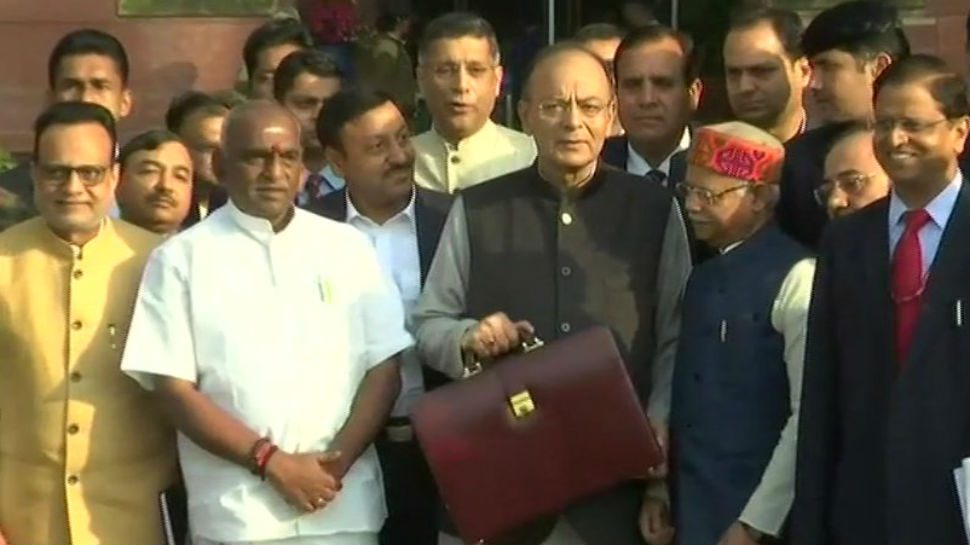The government would, without doubt, fail in doubling farm incomes by 2022 as promised. The kind of investment required to make that dream come true just did not exist. Don’t be surprised if many of the schemes to address farmer distress promised in this last full budget remained on paper. Increasingly, it has been getting clear that the Modi government talked tall but fell short. On delivery on promises, the government has no capacity. Here’s an analysis, for different Truths.
 Budget 2018-19 is a pre-election budget with a large number of schemes for deprived sections, from farmers to women to Scheduled Castes and Scheduled Tribes and senior citizens. There are increases in expenditures on many existing schemes for the poor and in the rural areas but the hard arithmetic is in the detail.
Budget 2018-19 is a pre-election budget with a large number of schemes for deprived sections, from farmers to women to Scheduled Castes and Scheduled Tribes and senior citizens. There are increases in expenditures on many existing schemes for the poor and in the rural areas but the hard arithmetic is in the detail.
Any budget impacts the economy as a whole for the coming year. It determines the direction the economy will take in the next 12 months. The problems that cropped up in 2017-18 were in the farm sector, underemployment and inadequate employment of educated youth, in private investment and in the stock markets. Problems in the education and health sectors are perennial.

 Top of all those, the Finance Minister faced the twin challenges of the effects of demonetisation and GST on the economy. He was forced to finally admit, through this budget, that the two measures were ill-timed, had hurt GDP growth and impacted employment in the unorganised sectors besides adversely affecting the farm sector. Jaitley had to try and correct these problems but revenues were not enough. And time, too. Even as he read out his last full budget, electoral news from Jaipur was full of despair for the ruling party.
Top of all those, the Finance Minister faced the twin challenges of the effects of demonetisation and GST on the economy. He was forced to finally admit, through this budget, that the two measures were ill-timed, had hurt GDP growth and impacted employment in the unorganised sectors besides adversely affecting the farm sector. Jaitley had to try and correct these problems but revenues were not enough. And time, too. Even as he read out his last full budget, electoral news from Jaipur was full of despair for the ruling party.
The government claimed a higher direct tax buoyancy but GST saw to it that there was a slippage in revenue. The situation was aggravated by the extra cost of demonetisation despite disinvestment. There was also slippage in revenue from the auction of spectrum. The slowdown in the economy was real.
Revenue shortfall affected fiscal deficit. The government would be forced to cut expenditures in the remaining three months of this fiscal. The cuts would be in education and health and would affect employment generation. The unorganised sector was hit hard both by GST and demonetisation. That was where the growth rate fell.
 These sectors needed a boost. Not just the MSME sector but the micro- and home-based sectors, which were hard to impact directly in the budget because they were not in the tax net. A tax cut does not help them. What they needed was indirect support via investments in education and health. A large number of schemes announced in these sectors would require expenditures not to be found in the expenditures from the budget. The burden would fall on extra-budgetary resources and the public sector.
These sectors needed a boost. Not just the MSME sector but the micro- and home-based sectors, which were hard to impact directly in the budget because they were not in the tax net. A tax cut does not help them. What they needed was indirect support via investments in education and health. A large number of schemes announced in these sectors would require expenditures not to be found in the expenditures from the budget. The burden would fall on extra-budgetary resources and the public sector.
This has been the pattern. All social responsibility has fallen on public sector units, pushing up their costs, making them sick. It happened with public sector banks after demonetisation. The next step would then be divestment of these entities, giving the government the chance to announce popular schemes and further push public sector disinvestment.
It was a clever ploy, Prime Minister Narendra Modi clubbing “ease of living” with “ease of doing business” – a political slogan that would not take the BJP first past the pole if that was the intention. The impression sought to be given was that the budget was focused on the common man’s welfare.
 The government would, without doubt, fail in doubling farm incomes by 2022 as promised. The kind of investment required to make that dream come true just did not exist. Don’t be surprised if many of the schemes to address farmer distress promised in this last full budget remained on paper. Increasingly, it has been getting clear that the Modi government talked tall but fell short. On delivery on promises, the government has no capacity.
The government would, without doubt, fail in doubling farm incomes by 2022 as promised. The kind of investment required to make that dream come true just did not exist. Don’t be surprised if many of the schemes to address farmer distress promised in this last full budget remained on paper. Increasingly, it has been getting clear that the Modi government talked tall but fell short. On delivery on promises, the government has no capacity.
The corporate sector has also not got the kind of concessions it looked for. The signal from Davos and the signal from Lok Sabha were not the same. No wonder the markets crashed even as Jaitley laid out his budget. The big danger could be FII fleeing to other shores.
The need of the hour was demand revival and job creation. The budget could be rated high on the election-scale but it would produce a political dividend only if elections were to be held ASAP. The Modi-Shah election juggernaut has been on a slippery slope despite electoral victories. By mid-2018, it would lose the traction required for a 2019 triumph.
Jay Bhagwan
©IPA Service
Photos from the Internet
#LokSabha #ModiGovernment #Budget #Jaitley #PrimeMinisterNarendraModi #IndianEconomy #Income #Demonetisation #Tax #FiscalDeficit #Revenue #IPA #DifferentTruths






 By
By
